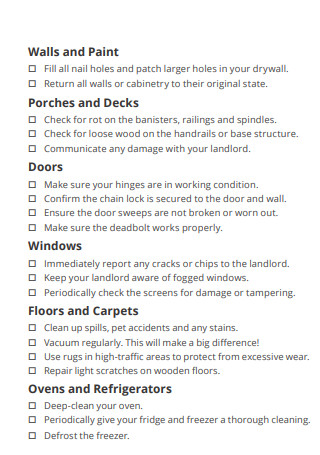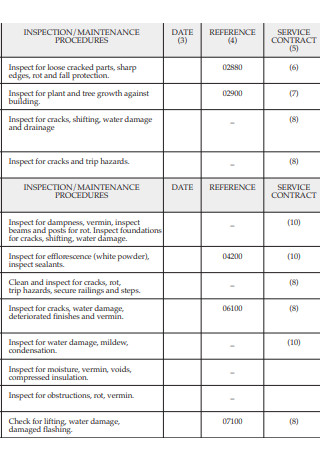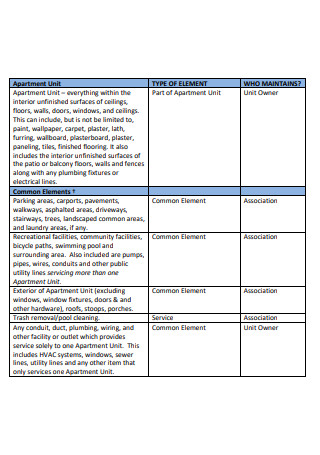4+ SAMPLE Apartment Maintenance Checklist
FREE Apartment Maintenance Checklist s to Download
4+ SAMPLE Apartment Maintenance Checklist
What Is an Apartment Maintenance Checklist?
Why Is an Apartment Maintenance Important?
What Does Apartment Maintenance Include?
Types of Apartment Maintenance Workers and Types of Maintenance:
Types of Maintenance:
Steps in Conducting an Apartment Maintenance Checklist:
Examples of Apartment Maintenance:
FAQs
What is the easiest way to schedule apartment maintenance tasks?
What is considered an emergency for apartment maintenance?
How to become an apartment maintenance technician?
Do apartment maintenance workers get rent free?
How do I manage schedules with residents?
In order to make a rental property business continue to be profitable, there should be the good presentation through usage of Apartment Maintenance Checklist to get hold of what needs repair or renovation to be livable for the tenants.
What Is an Apartment Maintenance Checklist?
Apartment maintenance checklist refers to list of activities or tasks that keep residential facilities safe, habitable, and enjoyable. It contains cleaning, groundskeeping, pest control, plumbing, HVAC repairs, and landscaping, among other tasks. The maintenance technicians, apartment supervisors, and apartment managers oversee these routine tasks.
The property owners must make sure their buildings are safe, comfortable, and habitable. Apartment maintenance plays a vital role in attaining this goal. In addition, maintenance technicians perform both reactive maintenance activities, as requested by tenants, and preventive maintenance tasks, as recommended by manufacturer guidelines and government facilities.
Moreover, apartment maintenance teams should respond to emergency service requests like plumbing, air conditioning, and heating within 24 hours to avoid legal issues and keep the tenants happy.
Why Is an Apartment Maintenance Important?
Apartment maintenance is important to identify every issue in the move-in and move-out inspection; to document items for deferred maintenance; to keep maintenance crews on track; to formulate move-out givens to reduce questions and gray areas; to get that apartment as close to perfect as possible to start renters off right; to make sure of the apartment readiness with a final quality control checklist; to protect yourself from challenges and lawsuits; to get more value from work order request; to keep the residents renting longer; to implement a thorough preventive maintenance process; to capitalize on curb appeal factor and; to have a clear and helpful training tool.
What Does Apartment Maintenance Include?
When leasing an apartment, there may not be an additional maintenance fee; however, a portion of the monthly rent goes to fund these supportive services.
Apartment maintenance is vital for ensuring that a property stays in good condition, making it livable, comfortable, and presentable for both residents and prospective tenants.
There is a varied range of services that fall under apartment maintenance. Normally, apartment maintenance includes plumbing, HVAC, appliance repair, security, groundskeeping, and pest control.
Added amenities offered at properties can call for more maintenance. For instance, if an apartment offers a gym or pool, then property management is automatically responsible for keeping these spaces up to par.
While property management regularly keeps up with the maintenance of the exterior and common space of the building, it is generally the tenant’s responsibility to communicate if their unit needs service.
Types of Apartment Maintenance Workers and Types of Maintenance:
Ensuring structures are secure, including floors, stairs, walls, and roofs.
Deep cleaning swimming pools, gymnasiums, and common areas.
Power-washing concrete driveways, hallways, and stairways.
Preventing and exterminating rodent, termite, and insect infestations.
Routinely inspecting apartment assets for workability.
Maintaining electrical, plumbing, heating, ventilating, and air-conditioning systems.
As one might expect, no day’s work looks the same. On Monday, the job may involve replacing worn doorknobs, oiling squeaky hinges, and replacing a damaged floorboard. While, Tuesday may involve changing air filters before troubleshooting an emergency work order request for a burst pipe.
Workers rely on several tools to complete tasks. These include flashlights, pliers, tape measures, screwdrivers, duct tape, non-contact voltage testers, and drywall repair kits, among others.
Apartment Maintenance Managers. Based on their average number of open work orders and the average time to complete them, apartment maintenance managers build the facility maintenance teams. A general hiring ratio is two technicians per 100 units. The manager’s primary responsibility is planning, scheduling, and strategizing maintenance tasks. In most cases, maintenance managers are also responsible for fulfilling work orders themselves. Facilities with less than 100 units commonly hire a “Jack of all trades.” Nevertheless, those overseeing apartment technicians assign work orders, coordinate preventive maintenance tasks, and look for cost-savings opportunities.Apartment Supervisors. Large facilities that have quite a lot of maintenance technicians need a maintenance supervisor. Apartment supervisors issue maintenance checklists, oversee the completion of daily tasks, and ensure safety standards are met. To receive and schedule maintenance requests from tenants, maintenance managers and supervisors rely on Computerized Maintenance Management Systems (CMMS). CMMS also help to assign work orders, share progress among maintenance personnel, and monitor inventory levels.Types of Maintenance:
To be able to generate a positive and productive property maintenance plan, you must understand that there are three main types of maintenance and make sure that the plan involves each of these types. According to property management professionals, these types include preventive, routine, and requested. Below is the general explanation of each:
Steps in Conducting an Apartment Maintenance Checklist:
Make it easier for you to start conducting an apartment maintenance through the steps below.
General:
Tile and hardwood floors (loosening, scuffs, scratches, cracks)
Carpeting (stains, tears, holes, burn marks)
Walls and ceilings (nails, holes, hooks, marks, chipping paint)
Ceiling fan (loosening)
Windows, screen, and tracks (cracks, tears)
Blinds and shades (tears, damage)
Door, conventional and sliding (tracks, dents, scuffs)
Bathroom:
Sink and drain (signs of leakage)
Bath and shower (signs of leakage)
Grout (signs of leakage)
Cabinets and drawers, inside and out (shelving, handles/knobs, scratches, scuffs)
Exhaust fan (filter)
Vanity top and mirror
Kitchen:
Sinks and drain (signs of leakage)
Garbage disposal (signs of leakage)
Countertops (scratches, burns, marks)
Pantry, cabinetry, and drawers, inside and out (shelving, handles/knobs, scratches, scuffs)
Microwave
Stovetop and oven
Exhaust fan and light (filter)
Refrigerator and icemaker (door seal, drawer and platform cracks, signs of leakage)
Dishwasher (signs of leakage)
Bedrooms:
Blinds
Ceiling fan
Closet rod/racks
Closet/drawer knobs
Crown molding
Doorstop/hinges/closer
Flooring
Light fixtures
Privacy lockset
Smoke/co2 alarms
Wall base/base trim
Wall plates
Window screens
Additional
Smoke detectors (batteries)
Carbon monoxide (batteries)
Light fixtures and bulbs
Patio/deck/terrace
Examples of Apartment Maintenance:
Diverse types of facilities that rely on apartment maintenance include:
- Garden Apartments: These are ground-floor apartments with a lawn or a garden. Garden apartments need maintenance to keep the lawns or gardens neat and beautiful.
- Walk-Ups: These are storied apartments without elevators. Tenants access the upper floors by stairs. The stairs should be clean and in good condition to avoid accidental falls. They should also have good lighting for easy visibility.
- High-Rise Apartments: High-rise apartments usually have at least 12 stories. They require elevators for easy access. The elevators require preventive maintenance to stay in good working condition.
- Duplexes: Apartments located on two separate floors or share a wall are referred to as duplexes. They may share a single kitchen and dining room, but the floors may have separate entries. Maintenance helps to keep the common areas clean and tidy.
- Triplexes: Triplexes are apartments that are divided into three self-contained residences. Each unit requires maintenance to ensure that everything is in good working order.
- Studio Apartments: Studio apartments are self-contained spaces with everything in a single room except the bathroom. Because they are a small one-room space, studio apartments don’t require as extensive maintenance as other types of apartments.
- Lofts: Lofts are large, open rooms with few walls, large windows, and high ceilings. They usually feel uncrowded and airy. Most lofts are former industrial and factory buildings that were converted into residential buildings. Lofts need proper maintenance to retain their aesthetic value.
The tenants are accountable for maintaining the condition of their apartments. Most lease agreements specify maintenance tasks that fall under the tenant’s responsibility. Some routine tasks, such as replacing apartment light bulbs, are the responsibility of the tenant.
FAQs
What is the easiest way to schedule apartment maintenance tasks?
The best way to schedule apartment maintenance tasks is with the help of a CMMS. It makes it easy to receive work requests from tenants, analyze the requests, and assign work orders to technicians. CMMS helps maintenance teams focus more on the actual tasks instead of paperwork. CMMS software can streamline maintenance tasks by providing a central database in which resources are organized and work orders assigned to maintenance technicians. Per Plant Engineering, spreadsheets (55%) and CMMS software (53%) are the most used technologies for managing maintenance in industrial and manufacturing facilities. In the current years, cloud-based CMMS software has become increasingly inexpensive, putting its use within reach for even the smallest maintenance teams. Nevertheless, most apartment maintenance teams still rely on a combination of spreadsheets, paper work orders, and white boards for task management.
What is considered an emergency for apartment maintenance?
Common preventative maintenance activities include arranging for garbage removal, mowing lawns, replacing air filters, clearing yard waste, and maintaining utility systems. Property owners should take a preventative maintenance (PM) approach to apartment maintenance to reduce the need for emergency maintenance as much as possible. However, problems are bound to occur even with the best PM measures in place. Emergency apartment maintenance refers to activities undertaken to repair assets with critical functions such as toilets, plumbing system, and HVAC units. Because tenants deeply rely on these items for comfort and safety, any issues must be remedied as soon as possible. Further problems requiring emergency maintenance include mold, water leaks, gas leaks, broken doors and windows, and electrical problems. Most lease agreements include procedures for reporting and handling emergency maintenance. Tenants should be encouraged to notify management of such issues as soon as they are noticed. Regular inspections can also help to identify problems.
How to become an apartment maintenance technician?
Most maintenance technician positions require a high school diploma and entry-level experience. Workers should have high physical stamina because tasks can be labor-intensive and involve heavy lifting. Moreover, skills needed for apartment maintenance include the ability to operate hand tools, customer service skills, and troubleshooting skills.
Do apartment maintenance workers get rent free?
Just a few properties offer free rent for maintenance workers. Apartment managers who get an apartment that also serves as their office pay income tax on their rent compensation. On the other hand, maintenance workers sometimes get a rent discount of up to 15 percent when offered an apartment on the property.
How do I manage schedules with residents?
Coordinating property maintenance service schedules with residents can help make them seem less disruptive and inconvenient for renters. Property maintenance services can be an inconvenience for renters—especially when the plumber has to turn the water off to fix the problem. Nevertheless, this can be problematic. One of the modest ways to coordinate with residents is to reach out to them via phone, text, or email a week or two before you want to schedule property maintenance services. This gives the renter time to prepare beforehand and clear their schedule or arrange to be out of the unit as necessary. It is important to make sure that they have received the message to ensure optimal coordination. It may be helpful to have renters friended on Facebook or similarly tracked on social media accounts to send them messages on these platforms as well—or to create a company page for your property management business and have them follow it so they can receive alerts and notifications. It may also help to ask if there is a particular time of day or night that would be best for the renter’s schedule. For instance, if a renter works the night shift, you may not want to have maintenance service techs show up in the middle of the day. Renters want to know you’re on top of any problems that come up. Review and approve their maintenance requests and empower them to order and schedule work at their convenience.
When the maintenance plan is accomplished, it must be immediately implemented and placed within the manual pertaining to your property maintenance. Regular maintenance should start immediately and all involved should be held to a high level of accountability.
When new equipment, property renovations, or even changes in staffing occurs, the plan should be properly revised to reflect these situations. By taking the steps essential to optimize maintenance in your structure, you are taking the steps necessary to prevent future issues and ensure the highest satisfaction among your tenants and the community where your apartment building is located.
Apartment maintenance is key to keeping multifamily residences neat, functional, and safe. Maintenance technicians perform routine preventive maintenance to ensure that building systems aren’t compromised. They work under the supervision of maintenance supervisors or managers.
Additionally, the majority of the work requests submitted to management are fairly quick fixes, such as faucet leaks, flickering bulbs, lack of warm water, and minor appliance issues. Each of these can be resolved in an hour or less. Some problems are more time-consuming, but still fall within the realm of their technicians’ expertise.
For problems that are beyond the maintenance crew’s capabilities, such as major appliance malfunctions or electrical issues, management hires outside contractors. Sporadically, they will get work requests for issues outside of their housing residences, such as lobbies, elevators, and lounge areas.
Furthermore, the workload spikes dramatically after spring semester when most students head home for the summer since many of their student tenants don’t submit work requests while attending school, these issues are often left unresolved, and the property manager will hire a few temporary maintenance workers to get everything fixed up before leasing those units again. It is highly advisable to be compliant to avoid inconvenience of each other.





